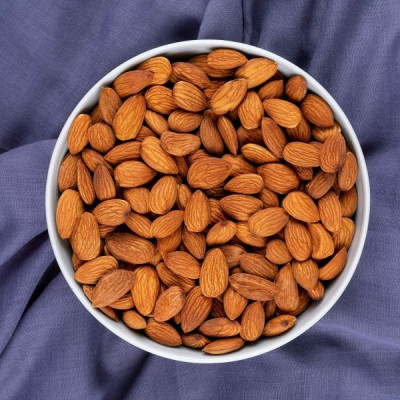DRY FRUITS
Discovering the Unique Flavors of Almonds: Kashmiri Mamra, California, and Gurbandi"
ABOUT KASHMIRI MAMRA, CALIFORNIA ALMONDS, AND GURBANDI ALMONDS
Almonds are a popular nut used in a variety of dishes worldwide. Among the different types of almonds, Kashmiri Mamra, California almonds, and Gurbandi almonds stand out for their unique characteristics.
Kashmiri Mamra almonds are known for their smaller size and round shape, which make them perfect for use in Indian sweets and snack mixes. They have a sweet and nutty flavor with a slightly softer texture, which adds a satisfying crunch to any dish.
California almonds are larger and flatter than other types of almonds. They have a delicate flavor with a firm and crunchy texture, making them ideal for salads, baked goods, and almond-based products like almond milk and butter.
Gurbandi almonds are smaller and plumper compared to other types of almonds. They have a rich and buttery flavor with a soft and chewy texture, making them perfect for use in nut butter, gravies, and traditional Indian dishes like biryanis and curries. Whether you're a professional chef or a home cook, these three types of almonds offer a range of flavors and textures that can elevate any dish.
Unique Differences:
Origin: Kashmiri Mamra almonds are primarily grown in the Kashmir region of India, while California almonds are grown in California, USA, and Gurbandi almonds are primarily grown in Iran.
Size and Shape: Kashmiri Mamra almonds are relatively smaller and have a rounder shape compared to California almonds, which are larger and have a more elongated shape. Gurbandi almonds are also smaller than California almonds but are more elongated than Kashmiri Mamra almonds.
Taste and Texture: Kashmiri Mamra almonds have a unique flavor profile that is slightly sweeter and milder than California almonds. They also have a softer texture and are easier to chew. California almonds have a slightly more intense flavor and a crunchy texture. Gurbandi almonds have a distinct nutty flavor with a crunchy texture that is more similar to California almonds.
Nutritional Value: All three types of almonds are considered good sources of nutrients like protein, fiber, healthy fats, and vitamins and minerals such as vitamin E, magnesium, and potassium. However, the exact nutritional content may vary slightly based on factors such as growing conditions and processing methods.
Health Benefits:
Kashmiri Mamra Almonds: Kashmiri Mamra almonds have a higher oil content compared to other almonds, which makes them a rich source of healthy fats. They are also a good source of antioxidants, which help protect the body from oxidative stress and may reduce the risk of chronic diseases such as heart disease and cancer. Kashmiri Mamra almonds also contain vitamin E, which is beneficial for skin health and may improve immune function.
California Almonds: California almonds are a rich source of dietary fiber, which helps support digestive health and may lower the risk of chronic diseases such as type 2 diabetes and heart disease. They also contain high levels of magnesium, which is important for maintaining healthy bones and muscles. California almonds are also a good source of protein, which is important for building and repairing tissues in the body.
Gurbandi Almonds: Gurbandi almonds are a rich source of monounsaturated fats, which can help lower LDL cholesterol levels and reduce the risk of heart disease. They are also a good source of vitamin E and magnesium, which have various health benefits such as improving skin health, reducing inflammation, and supporting healthy bones and muscles.
Health Disadvantages:
Kashmiri Mamra Almonds: Kashmiri Mamra almonds contain a higher amount of oil compared to other almonds, which makes them more prone to rancidity and spoilage. Additionally, consuming too many almonds, including Kashmiri Mamra almonds, can cause digestive problems such as bloating and diarrhea due to their high fiber content. Also, some individuals may have an allergic reaction to almonds, including Kashmiri Mamra almonds, which can cause symptoms such as swelling, hives, and difficulty breathing.
California Almonds: California almonds may contain traces of aflatoxins, which are toxic substances produced by certain molds that can grow on the nuts. These toxins can be harmful when consumed in large amounts and may increase the risk of liver damage and cancer. However, the risk of aflatoxin contamination is generally low in commercially grown California almonds and is closely monitored by regulatory agencies.
Gurbandi Almonds: Gurbandi almonds, like other almonds, contain a high amount of calories and fat, which can contribute to weight gain if consumed in excess. Additionally, some individuals may be allergic to almonds, including Gurbandi almonds, which can cause symptoms such as itching, swelling, and difficulty breathing.
*NOTE: while these health disadvantages are possible, they are generally rare and can be mitigated by consuming almonds in moderation and selecting high-quality, fresh nuts. It is always a good idea to speak with a healthcare professional before adding almonds or any other food to your diet, especially if you have a known allergy or medical condition.
Almond Allergies- Who Should Avoid:
Most people can safely consume Kashmiri Mamra almonds, California almonds, and Gurbandi almonds as part of a healthy diet. However, some groups of individuals should exercise caution or avoid consuming almonds altogether, including:
Individuals with nut allergies: Almonds, including Kashmiri Mamra almonds, California almonds, and Gurbandi almonds, are common food allergens that can cause severe allergic reactions in some individuals. People with a known almond allergy should avoid consuming these nuts.
Infants and young children: Whole almonds, including those that have been ground into almond butter, can be a choking hazard for young children. Infants and young children should not be given whole almonds or almond products until they can chew and swallow them safely.
Individuals with digestive issues: Almonds, including Kashmiri Mamra almonds, California almonds, and Gurbandi almonds, are high in fiber and can cause digestive issues such as bloating, gas, and diarrhea in some people. Individuals with digestive issues or irritable bowel syndrome (IBS) may want to limit their intake of almonds or speak with a healthcare professional before consuming them.
Individuals taking certain medications: Almonds, including Kashmiri mama almonds, California almonds, and Gurbandi almonds, contain high levels of oxalates, which can interfere with the absorption of certain minerals, such as calcium and iron. Individuals taking medications that lower calcium or iron absorption, such as some antibiotics or antacids, should speak with a healthcare professional before consuming almonds.
*Note: while almonds are a healthy food for most people, certain individuals may need to limit or avoid their consumption due to allergies, choking hazards, digestive issues, or medication interactions. It is always a good idea to speak with a healthcare professional before adding almonds or any other food to your diet, especially if you have a known allergy or medical condition.
Almond Varieties: Culinary Uses
Kashmiri Mamra almonds, California almonds, and Gurbandi almonds are versatile ingredients that can add flavor, texture, and nutrition to a variety of dishes. Some unique reasons to use each type of almond in dishes, along with examples, are:
Kashmiri Mamra Almonds: Kashmiri Mamra almonds have a unique flavor and are often used in Indian cuisine to add a nutty, slightly sweet taste to dishes. They are also known for their crunchiness, which makes them a popular ingredient in snack mixes and trail mixes.
Some examples of dishes that use Kashmiri Mamra almonds include Indian sweets and desserts like kheer and halwa. Kashmiri Pulao, a fragrant rice dish made with spices, saffron, and almonds, and Chikki, a popular Indian sweet made with jaggery, peanuts, and almonds.
California Almonds: California almonds are the most widely grown type of almond and are popular in both sweet and savory dishes. They are often used in baking to add texture and flavor to cookies, cakes, and muffins. California almonds are also commonly used in salads and grain bowls to add protein and crunch.
Some examples of dishes that use California almonds include Almond-Crusted Chicken, a flavorful chicken dish coated in ground almonds and spices, and Almond Butter Chocolate Chip Cookies, a delicious twist on traditional chocolate chip cookies made with almond butter and almond flour.
Gurbandi Almonds: Gurbandi almonds are known for their high oil content and rich, buttery flavor. They are often used in Indian and Middle Eastern cuisine to add richness and depth to curries, sauces, and desserts. Gurbandi almonds are also commonly used in confectionery items like almond brittle, almond toffee, and almond pralines.
Some examples of dishes that use Gurbandi almonds include Indian dishes like biryanis and curries. Badam Halwa, a popular Indian dessert made with ground almonds, sugar, and ghee, and Ma'amoul, a traditional Middle Eastern cookie stuffed with dates or nuts and flavored with rosewater and orange blossom water.
*Note: each type of almond has unique qualities that make it well-suited for different types of dishes. Kashmiri Mamra almonds are ideal for Indian dishes and snack mixes, California almonds are versatile and can be used in sweet and savory dishes, and Gurbandi almonds are great for adding richness and flavor to desserts and confections.
Here are some Frequently asked questions (FAQ) for Kashmiri Mamra, California almonds, and Gurbandi almonds:
Q-1: What are the unique characteristics of each almond variety?
- Kashmiri Mamra almonds are small, dark brown, and have a sweeter taste compared to other almond varieties.
- California almonds are large, light brown, and have a delicate and nutty flavor.
- Gurbandi almonds are medium-sized, have a wrinkled surface, and have a rich buttery taste.
Q-2: What are the health benefits of each almond variety?
- Kashmiri Mamra almonds are rich in fiber, protein, and healthy fats, and can help improve digestion and lower cholesterol levels.
- California almonds are a good source of vitamin E, magnesium, and antioxidants, and can help reduce the risk of heart disease and diabetes.
- Gurbandi almonds are high in protein, fiber, and healthy fats, and can help boost brain function and reduce inflammation.
Q-3: How can each almond variety be used in cooking and baking?
- Kashmiri Mamra almonds are commonly used in Indian desserts and snack mixes.
- California almonds are often used in salads, baked goods, and almond milk.
- Gurbandi almonds are commonly used in nut butter, gravies, and as a snack.
Q-4: Can people with nut allergies consume these almond varieties?
- It is important to note that all almond varieties are considered tree nuts, and people with nut allergies should avoid them.
Q-5: Where can I buy these almond varieties?
- These almond varieties can be found in specialty food stores or online. It is important to purchase from reputable sources to ensure quality and freshness.






 FRUITS
FRUITS 





